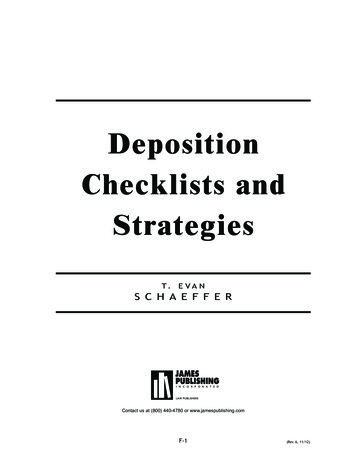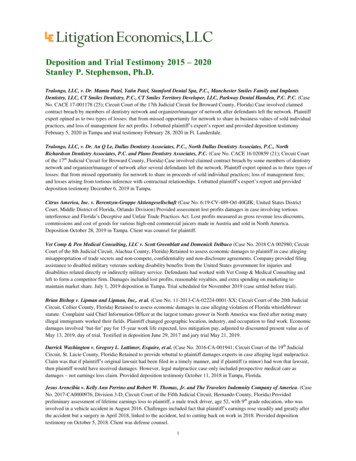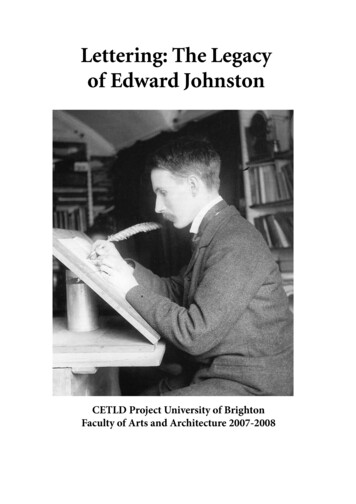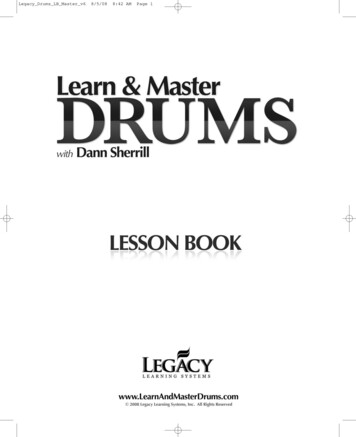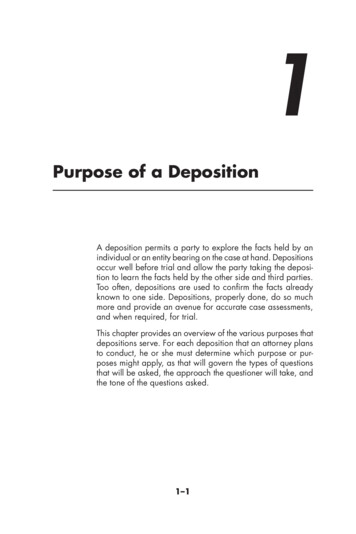
Transcription
1Purpose of a DepositionA deposition permits a party to explore the facts held by anindividual or an entity bearing on the case at hand. Depositionsoccur well before trial and allow the party taking the deposition to learn the facts held by the other side and third parties.Too often, depositions are used to confirm the facts alreadyknown to one side. Depositions, properly done, do so muchmore and provide an avenue for accurate case assessments,and when required, for trial.This chapter provides an overview of the various purposes thatdepositions serve. For each deposition that an attorney plansto conduct, he or she must determine which purpose or purposes might apply, as that will govern the types of questionsthat will be asked, the approach the questioner will take, andthe tone of the questions asked.1–1
Q 1.1Depositions Answer Book 2019The Purposes of a Deposition. 1–2A Discovery Deposition. 1–2A Deposition Seeking Admissions. 1–3A Deposition Testing Theories. 1–4A Deposition Supporting Trial Motions. 1–5A Deposition Preserves Testimony. 1–6A Deposition Permits Witness Evaluation. 1–7The Purposes of a DepositionQ 1.1What are the purposes of taking adeposition?There are at least six reasons to take a deposition:1.2.3.4.5.6.Seek discoverySeek admissionsTest theoriesGain material for motions or trialPreserve testimonyObserve witnesses for the other side.You may well develop other reasons, but do not fall for the false premise that a deposition can only be taken for one purpose at a time.Depositions often seek to cover all of these stated purposes simultaneously. Part of the pre-deposition preparation process requires figuring out the purposes you wish to cover and deciding the order inwhich to address each one.A Discovery DepositionQ 1.2How does a deposition seek discovery?Discovery comprises three types of materials—documents, physical evidence, and testimony. The deposition deals with the testimonial aspect, but can also lead to other types of discovery material.The deposition may use documentary and physical evidence, but it1–2
Purpose of a Deposition Q 1.3does so in a way that has a witness explain, expound, and add color.The deposition may also identify gaps in the prior document or physical discovery. The attorney for one side cannot roam through therecords of the opposition, but can ask questions to uncover how andwhere documents and other materials are stored, identify the custodians, and determine whether those locations have been searched forresponsive materials.Not all witnesses are candidates for assisting with discovery issues.Depending on the witness’s relation to the case, a witness might knowadditional areas of discovery or be helpful in explaining the discovery already provided. And, since most depositions are now subjectto a time limitation—for example, the Federal Rules of Civil Procedureprovide a presumptive seven-hour limitation (see chapter 2)—thequestioner must make careful allocation of the time spent seeking additional discovery. There are no hard and fast rules that govern the allocation of time to particular purposes. The questioner must be alert formissing gaps in the information provided and be prepared to explorethose missing gaps as the opportunity arises. For example, you probably would not think to pursue discovery issues with the CEO of acompany. But, if the discovery issue is key information that has yet tobe provided, a particularly good question for the CEO is who wouldhe/she ask for that information.A Deposition Seeking AdmissionsQ 1.3How does a deposition seek admissions?By framing the questions correctly, a skilled questioner can eliminate issues from the case. The secret is learning how to phrase thequestion (essentially to make it short, without qualifiers, and limited toa single fact; see discussion in chapter 6), listen carefully to the answer,and then rephrase the question to remove any words that preventedthe witness from answering the question with an unqualified yes. Sincemost witnesses are skeptical of deposition questions and look for waysto qualify their answers, the questioner must be prepared to spendthe time required to make each admission-seeking question very simple and clear.1–3
Q 1.4Depositions Answer Book 2019Admissions are the cornerstones of building your case. Each keyfact admitted by the other side leaves one less matter you must provein order to prevail. And, because it comes from the mouths of the otherside, the fact finder will give the admission greater weight. With admissions, you build your case theory. Sometimes, the building processrequires you to tear down your theory and start anew. This processpermits a strong case theory to arise eventually—one with which thefact finder can easily agree.Admissions also support motion practice. The best summary judgment motions are those that are based on concessions from the otherside that support your legal theory. But, most witnesses will not admitso readily that their case lacks legal merit or that they are skewing theevents to bolster their side, building on those small admissions untilthey show that result. The deposition skill becomes asking for smallconcessions that show that result.A Deposition Testing TheoriesQ 1.4How does a deposition test theories?Lawyers are constantly thinking of ways to explain to others whytheir side should prevail. In doing so, they hypothesize about themotives and rationale behind the decisions made by the other side.A defense lawyer might speculate that the plaintiff’s injuries are notrelated to use of the client’s product. The plaintiff’s lawyer might imagine that the defendant manufacturer ignored safety concerns to maximize profits. These lawyers might be right, but what if they are wrong?Imagine the impact at trial if the other side explains their actionsin such a way that defeats any theory of liability. Our hypotheticallawyer is devastated and the client’s case ends. Could this result havebeen avoided? Perhaps, through deposition questions, our hypothetical lawyer could have learned of the explanation before trial. Thatexplanation might confirm the original hypothesis. If not, the lawyerstill has time to develop a new theory or to revise the existing one toaccount for the explanation. The lawyer also has time to use additionaldiscovery to determine the strength of the explanation.Some lawyers believe that testing theories during the depositionprovides the other side with insight into their case. These lawyersbelieve that they can anticipate and negate any explanations that1–4
Purpose of a Deposition Q 1.5might be offered later. What if they are wrong? That is the risk takenby not exploring your case theories and confirming that the evidencewill allow that theory to prevail. Your client’s case suffers. And, sinceso few cases go to trial, what is the real goal of keeping your theoryfrom the other side? Odds are that the other side has a good feel forexactly the theory you will try to run anyway. It is equally likely thatthe other side will have tested its case theories during the depositionsof your witnesses. You might also find that the settlement value risesas the other side hears your theories confirmed.A Deposition Supporting Trial MotionsQ 1.5How do depositions gain material formotions or trial?In testing theories, the questioner should also seek specific factualconcessions that support the questioner’s side. Usually, there are anarray of facts not disputed. Using the deposition process to identifythe areas where there are no disputes goes a long way to establishsupport for a summary judgment motion. The motion can be tailoredto address only the areas in dispute. And, even if the summary judgment motion fails, knowing the areas of agreement will simplify thetrial testimony and number of witnesses required to prove undisputedpoints.To achieve this objective, you must have a handle on your client’sview of events and on what the documents show. These alone are notenough. You must also have a keen understanding of the law applicable to the claims being asserted. With the law as a guide, the questioner begins deposition preparation by outlining the factual areas toaddress the legal elements of the claim. A negligence case will focuson the actions that led to the incident, the circumstances surroundingthe parties at the time the incident occurred, and what could havebeen done to prevent the accident from happening. A contract casewill focus on a contract, its relevant terms, and the events leading tothe dispute over compliance with the terms of the contract.As you think about the questions that will assist with proving yourcase theory, assume that the case will proceed to trial. Always ask yourself how the information you seek in the deposition will assist with the1–5
Depositions Answer Book 2019Q 1.6trial and, as importantly, how the evidence will play in the courtroom.Those concepts assist in framing the areas of questions you want toask at the deposition and how the answers can be used in pretrialmotions.A Deposition Preserves TestimonyQ 1.6How can a deposition be used to preservetestimony?Sometimes there are concerns that the witness with important testimony about a key event will not be available for trial. In the bestof cases, this unavailability arises because of a vacation around theworld. In the worst of times, there is a fear that the witness will not livelong enough for discovery to proceed to the discovery phase. What todo in either case?The process will vary depending on the jurisdiction involved andwhether or not a complaint has already been filed. If the underlyingcase has not yet been filed and the case is in federal court, Rule 27 ofthe Federal Rules of Civil Procedure lays out the process:1.File a verified petition in the district where the expected deponent resides; and2.The petition must request an order permitting the depositionand must show:a.That the petitioner expects to be a party to an action in aU.S. court but cannot presently sue or cause suit to bebrought;b.The subject of the future action and the petitioner’s interest;c.The facts that the petitioner seeks to establish by thedeposition and the reason it must be perpetuated;1d.The identity of the expected adverse parties and theiraddresses; ande.The name and address of the proposed deponent andthe expected substance of their testimony.1–6
Purpose of a Deposition Q 1.7As you might expect, the anticipated adverse parties must receivenotice of the request at least twenty-one days before the hearing. Thecourt then “must” issue an order to perpetuate testimony if it finds thatdoing so “may prevent a failure or delay of justice.” The court mayallow the deposition only on written questions. But, if allowed, thedeposition may be used just as any other deposition in a case alreadyfiled.If the case is already filed, the question is whether the other sidewill agree that the deposition is needed to perpetuate testimony. If so,the normal deposition process addressed in more detail in chapter 5should be followed. You might also need to request court permissionif the time for deposition discovery has not yet arrived under the casemanagement order. If the other side fails to agree, the process is similar to that used prior to an action being filed. You must file a contestedmotion with the court and convince the court of the need to proceedwith the deposition prior to the normal discovery window.A Deposition Permits Witness EvaluationQ 1.7How does a deposition allow a party toevaluate witnesses?What a witness says is important. But, how a witness answers aquestion might be even more important. We have all met people whoare not believable no matter what they say. We do not like their attitude or their appearance and conclude that they will not make a greatwitness no matter what they have to say. The other side will make theexact same judgments about your witnesses. The deposition allowsyou to observe the witness and make those judgment calls.With the opportunity to observe comes the burden of asking enough“hard” questions to gauge realistically a witness’s demeanor. What’s ahard question? It is a question that goes to one of the key issues. A keyquestion seeks to uncover the party’s motive for behaving as they did,or to establish a disputed fact in your favor. The form of the questionis not “hard.” There is no need for shouting, a stern face, or any othermelodrama. Sometimes, the best question is simply “why did you dothat?”1–7
Q 1.7Depositions Answer Book 2019As you listen to the answer, pay attention to the words used by thewitness but pay more attention to the facial expressions and the bodylanguage. Those non-verbal signs are the ones that will guide yourassessment of the witness. And, you can use those non-verbal signsto tell you areas of inquiry where you must follow up. Witnesses oftengive non-verbal cues in areas where they are uncomfortable testifying.The skillful questioner seeks to identify the cause of the discomfort.1–8
Purpose of a DepositionNote to Chapter 11.The testimony sought to be perpetuated must be evidence that cannotcome easily from other sources. See In re Deiulemar Compagnia Di NavigazioneS.p.A., 198 F.3d 473 (4th Cir. 1999).1–9
Purpose of a Deposition Q 1.3. does so in a way that has a witness explain, expound, and add color. The deposition may also identify gaps in the prior document or physi-cal discovery. The attorney for one side cannot roam through the records of the opposition, but can ask questions to uncover how and
